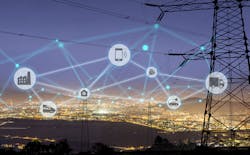Lights on or lights off? National utility grids are fragile. One flick of the switch and things can go down quickly. It's not just electricity either. Rising energy costs, severe droughts, and surges in usage have impacted many of our power grids across the country -- adding strain and creating fragility.
Adding another layer of complexity, the grids are increasingly vulnerable to cyberattacks, pushing their health and stability to hang in the balance. Data reveals that over 77% of assets are vulnerable to cyber threats.
According to the U.S. Government Accountability Office (GAO), grid distribution systems have grown more vulnerable over the years. Like most enterprises, utility grids have many controlled systems on a closed or open network.
For example, electrical grids utilize a wide variety of internet-connected systems, from Windows servers to Programmable Logic Controllers. It’s one of the reasons the U.S. Department of Energy recently allocated over $45 million to protect the grid. However, the majority (90%) of the nation’s power infrastructure is privately held, meaning individual companies are responsible for protecting their systems from risk.
Organizations are using more IoT devices; therefore, increased pressure is put on the grid and more weaknesses are exposed. This exposure provides threat actors with further opportunities to disrupt operations.As utilities evolve and deploy more industrial controls, such as smart systems from access controls to meters, greater connectivity gives way to greater risk. These IoT devices are prime targets for attackers and many utilities don’t have thorough monitoring methods for detecting unusual or unauthorized activities. This gives bad actors a considerable vector into an organization's network.
The repercussions of an attack could be astronomical – public safety chaos from prolonged downtime, the unauthorized control of hazardous systems, such as nuclear power plants, to a potential public health crisis if water distribution systems go down.
The list goes on. Remember the Ukraine power grid attack in 2015? Over 200,000 people were without power for hours. If it happened once, it could happen again.
Criminal groups, state-sponsored or not, pose a significant cyber threat to the grid infrastructure, according to the Director of National Intelligence's 2022 Annual Threat Assessment.
Several U.S. Federal Government agencies have issued warnings for industrial control system (ICS) devices as a threat vector for state-backed hackers using them for malware. Earlier this year, CISA, DOE, NSA, and the FBI released warnings regarding this issue.
The Federal Energy Regulatory Commission (FERC) – which regulates the interstate transmission of electricity – approved mandatory grid cybersecurity standards. Still, the steps to ensure it doesn't happen are unfortunately inadequate. Incorrect configurations and poor maintenance regimes point to a weak cyber policy and posture that needs modernization.
The only way utility companies can take matters into their own hands and prepare for potential attacks is to think and act like an attacker. Adopting a proactive cybersecurity posture allows for this. Here are three ways to start:
#1: Embrace Offensive Security
Properly configured firewalls and other perimeter devices are essential, but it's a defensive strategy. There are two reasons why more is needed. First, it assumes that you are protecting your organization against external threats only. This ignores the danger that organizations can have internally.
Secondly, you are relying on devices to stay up to date (patched, scanned, maintained, etc.) and are configured correctly. Most companies don't assess these devices frequently, audits may only occur once a year, and not all devices are checked, so many companies are flying blind as to whether a network is entirely secure.
Offensive security involves identifying issues before they are detected and before bad actors can exploit them. Essentially, you’re trying to break in before someone else does.
And no, vulnerability scanning alone doesn’t cut it. Defensive cyber is still a critical part of a company's cyber policy for perimeter, response capability, and reaction time.
Still, only the deployment of both offensive and defensive security will provide maximum protection. Defensive objectives protect and detect, while offensive objectives seek to circumvent, exploit, and compromise. You can say your defense is solid all day long, but until you have sophisticated hackers attempt to breach it, you don’t fully know.
#2: Deploy continuous threat simulation
Companies need to constantly throw threats and real-world attacks at a system to ensure there aren't weaknesses. Compliance can't be the security driver, nor can one or two penetration tests.
Hackers don't work once or twice a year. Businesses are susceptible all the time and they need to be tested continuously. This involves adopting a continuous testing model that includes at least a dozen external tests each year – one per month that varies between planned and unplanned attacks.
These attacks should consist of mimicking outside and inside threats. This type of cyclical testing helps fortify your environment and account for any changes made (known and unknown).
In addition, continuous threat simulation provides useful metrics (trends, historical data) and fosters more robust security. Organizations can save money and resources by reducing time spent on unplanned work due to breaches.
#3: Rely on humans, not just scans
It's easy to rely on technology to scan for vulnerabilities. But technology can't adapt on the fly; only humans can do that. Automated tools can’t always figure out how to circumvent a system or use custom code to get past protocols unique to an organization. That’s because automated tools are based on preloaded definitions or playbooks.
Professional hackers are the opposite. They can be creative. They have engineering and development backgrounds, as well as an aptitude for thinking like the enemy, which they use to expose gaps and potential exploits.
Cybercriminals know the latest tricks and can figure out ways, new and old, to hold systems ransom or access controls that can shut down a company in minutes. Put a solid human hacker up against an automated test tool; without a doubt, the human will generate more significant results.
Summing it Up
Utility companies must change their cybersecurity posture and ways of thinking to include offensive measures alongside their defense. It will allow them to stay one step ahead of cybercriminals.
Grids are powerful, necessary, and ideal targets for breaches. If they aren't secured properly, it will result in a disaster for the community, businesses, economy, and local and national security.
Utility companies can't afford to only be defensive. The increasing rate of cyber insurance is expected to surge over the next decade as attacks increase, turning it into a $34 billion industry by 2031. It's clear why. By adopting an offensive cybersecurity strategy, companies can save millions of dollars while protecting not only their systems but also proprietary and financial data.
The old saying of "stay one step ahead" applies to cyber criminals. With an offensive cybersecurity strategy, you can be two steps ahead, discovering where gaps and weaknesses are and allowing internal defenses to remediate as needed.
About the author: Luke Secrist is CEO at BuddoBot. A veteran of the U.S. Marine Corps, Secrist began his career in military defense contracting as an IT security engineer and systems manager. While working for companies of different sizes, his desire to start a cybersecurity business of his own grew. He envisioned a commercial startup that would cultivate subject matter expertise and creativity in a structured-yet-deconstructed environment. He realized this dream in 2008 with BuddoBot, a cybersecurity firm that takes an offensive (vs. defensive) approach to protect its customers' IT systems from bad actors.



